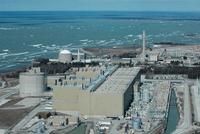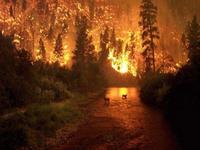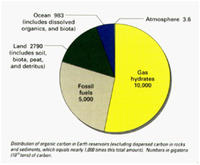-
Climate benefit of biofuels from corn residue questioned
Using corn crop residue to make ethanol and other biofuels reduces soil carbon and generates more greenhouse gases than gasoline, according to a new study. The findings cast doubt on whether corn residue can be used to meet federal mandates to ramp up ethanol production and reduce greenhouse gas emissions.
-
-
Court to decide a Minnesota’s “Buy the Farm” case
Minnesota’s “Buy the Farm” law is the center of a case set for trial later this week, in which developers of CapX2020, the region’s power grid improvement project, will contest a lawsuit by Cedar Summit Farm. The state law requires utilities building high-voltage power lines to buy out farms along the path of the power line if the affected landowners demand it. CapX2020 argues the farm does not meet the buyout criteria set in the law.
-
-
Debate over Ontario, Canada underground nuclear waste facility intensifies

Ontario Power Generation’s (OPG) proposal to construct an underground nuclear waste disposal facility near the company’s Bruce Nuclear plantand on the edge of the Great Lakes is facing growing opposition from local municipalities and environmentalists. The facility would store low and intermediate nuclear waste from OPG’s Bruce, Pickering, and Darlington nuclear facilities. Environmentalists are concerned that a leak in the underground facility would be devastating for communities which depend on water from the Great Lakes.
-
-
Dynamic atolls give hope that Pacific Islands can defy sea rise
It is widely predicted that low-lying coral reef islands will drown as a result of sea-level rise, leaving their populations as environmental refugees. New evidence, however, now suggests that these small islands will be more resilient to sea-level rise than we thought. The new findings suggest that, rather than being passive lumps of rock that will be swamped by rising seas and eroded by storms, the islands are dynamic structures that can move and even grow in response to changing seas. Although the islands may survive into the future, the changes could still affect issues like fresh water and agriculture, potentially making life on these islands much more difficult than it is today.
-
-
More, bigger wildfires burning western U.S.

Wildfires across the western United States have been getting bigger and more frequent over the last thirty years — a trend that could continue as climate change causes temperatures to rise and drought to become more severe in the coming decades, according to new research.
-
-
Red Team’s concepts, approach gain support
Headed by Thom Mason, director of Oak Ridge National Laboratory (ORNL), Red Team aims to modernize the uranium processing procedure on a budget of $4.2 billion to $6.5 billion. Even before Red Teamdelivered its report on alternatives to the expensive Uranium Processing Facility (UPF) at the Y-12 nuclear weapons plant by the 15 April 2014 deadline, the group of experts, who come from different disciplines, had already gained support among energy officials and some members of Congress.
-
-
Floating nuclear plants could ride out tsunamis
When an earthquake and tsunami struck the Fukushima Daiichi nuclear plant complex in 2011, neither the quake nor the inundation caused the ensuing contamination. Rather, it was the aftereffects — specifically, the lack of cooling for the reactor cores, due to a shutdown of all power at the station — that caused most of the harm. A new design for nuclear plants built on floating platforms, modeled after those used for offshore oil drilling, could help avoid such consequences in the future. Such floating plants would be designed to be automatically cooled by the surrounding seawater in a worst-case scenario, which would indefinitely prevent any melting of fuel rods, or escape of radioactive material.
-
-
Long-term predictions for Miami sea level rise could be available soon
Researchers say that Miami could know as early as 2020 how high sea levels will rise into the next century. Scientists conclude that sea level rise is one of the most certain consequences of climate change. The speed and long-term height of that rise, however, are unknown. Some researchers believe that sea level rise is accelerating, some suggest the rate is holding steady, while others say it is decelerating. Scientists say that numbers should continue to be crunched every decade, creating more certainty in long-term planning — and helping develop solutions for a changing planet.
-
-
A few “problem” shale gas wells source of greenhouse gas

High levels of the greenhouse gas methane were found above shale gas wells at a production point not thought to be an important emissions source, according to a new study. The findings could have implications for the evaluation of the environmental impacts from natural gas production. The study, which is one of only a few to use a so-called “top down” approach that measures methane gas levels in the air above wells, identified seven individual well pads with high emission levels and established their stage in the shale-gas development process.
-
-
How building codes save homes from cyclones, and how they don’t
During Queensland’s preparations for Severe Tropical Cyclone Ita, Queensland Premier Campbell Newman advised residents who lived in older houses (those built before 1985) to evacuate their homes as they were not likely to stand up to the storm’s destructive winds. That was the year that building regulations changed to require new houses in cyclone-prone areas to be able to withstand higher winds. But how were these regulations determined, what do they mean for modern homes, and why do regulators always seem to wait until after a severe storm before updating the codes?
-
-
West Point wins Cyber Defense Exercise, launches Army Cyber Institute
The U.S. Military Academy at West Point has won the annual Cyber Defense Exercise (CDX) which brought together senior cadets from the five service academies for a 4-day battle to test their cybersecurity skills against the National Security Agency’s (NSA) top information assurance professionals. West Point’s win comes just as the academy announced plans for its Army Cyber Institute(ACI), intended to develop elite cyber troops for the Pentagon.
-
-
High-altitude wind energy shows promise
Wind turbines hovering high in the air and tethered to the ground, like kites, have the potential to generate huge amounts of electricity, based on a recent wind availability study. Researchers pinpointed tracts of the atmosphere ideal for locating airborne wind energy (AWE) devices, which convert kinetic energy from wind into electricity. Recently published research shows that there are enough areas usable by airborne turbines to produce several terawatts of electric power annually — more than enough needed to meet worldwide demands. More than twenty companies are developing various versions of the technology, with over 100 related patents filed in the United States alone.
-
-
How the Heartbleed bug reveals a flaw in online security
The Heartbleed bug – which infects an extremely widespread piece of software called OpenSSL — has potentially exposed the personal and financial data of millions of people stored online has also exposed a hole in the way some security software is developed and used. The Heartbleed bug represents a massive failure of risk analysis. OpenSSL’s design prioritizes performance over security, which probably no longer makes sense. But the bigger failure in risk analysis lies with the organizations which use OpenSSL and other software like it. A huge array of businesses, including very large IT businesses with the resources to act, did not take any steps in advance to mitigate the losses. They could have chosen to fund a replacement using more secure technologies, and they could have chosen to fund better auditing and testing of OpenSSL so that bugs such as this are caught before deployment. They didn’t do either, so they — and now we — wear the consequences, which likely far exceed the costs of mitigation.
-
-
Making ethanol without corn or other plants
Ethanol today is produced at high-temperature fermentation facilities that chemically convert corn, sugarcane, and other plants into liquid fuel. Growing crops for biofuel, however, requires thousands of acres of land and vast quantities of fertilizer and water. In some parts of the United States, it takes more than 800 gallons of water to grow a bushel of corn, which, in turn, yields about three gallons of ethanol. Stanford scientists have created a copper-based catalyst that produces large quantities of ethanol from carbon monoxide gas at room temperature.
-
-
California implements earthquakes’ lessons
In California, government engineers study structures that did not survive the earthquake, with plans to make improvements to building codes. The most important code changes tend to occur because earthquakes uncover weaknesses in contemporary construction standards.”Every time the earth shakes there’s something a little different about it,” says one official.
-
More headlines
The long view
Helping Strengthen America’s Critical Infrastructure
By Corinne Dionisio
Everyday life depends on a robust infrastructure network that provides access to running water, communications technology and electricity, among other basic necessities. The experts who keep our national infrastructure secure and resilient also need a strong network to share their knowledge and train the next generation of professionals capable of solving complex infrastructure challenges.
AI and the Future of the U.S. Electric Grid
By Doug Irving
Despite its age, the U.S. electric grid remains one of the great workhorses of modern life. Whether it can maintain that performance over the next few years may determine how well the U.S. competes in an AI-driven world.
Using Liquid Air for Grid-Scale Energy Storage
By Nancy W. Stauffer
New research finds liquid air energy storage could be the lowest-cost option for ensuring a continuous power supply on a future grid dominated by carbon-free but intermittent sources of electricity.
Enhanced Geothermal Systems: A Promising Source of Round-the-Clock Energy
By Julie Bobyock and Christina Procopiou
With its capacity to provide 24/7 power, many are warming up to the prospect of geothermal energy. Scientists are currently working to advance human-made reservoirs in Earth’s deep subsurface to stimulate the activity that exists within natural geothermal systems.
Experts Discuss Geothermal Potential
By Graeme Beardsmore and Rachel Webster, University of Melbourne
Geothermal energy harnesses the heat from within Earth—the term comes from the Greek words geo (earth) and therme (heat). It is an energy source that has the potential to power all our energy needs for billions of years.
